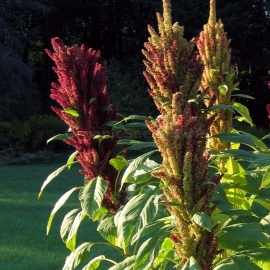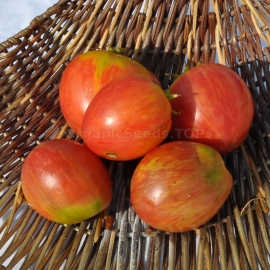 EXCLUSIVE
EXCLUSIVE
«Popping» - Organic Amaranth Seeds
1.78 €
The plant is up to 2 meters high, very high-yielding (300-500 grams of seeds per plant), the grain is small, white, from which delicious various dishes are prepared.
-
Amaranth popping
Plant up to 2 meters high, very high-yielding (300-500 grams of seeds per plant). The grain is small, white in color, from which delicious various dishes are prepared.
The homeland of amaranth is Central and South America. Currently cultivated in America, Europe, Asia, Africa. Breeders have bred zoned amaranth varieties adapted to specific growing conditions.
Amaranth is characterized by a low sugar value and a high protein content. Of the macronutrients, K (1.2%), Ca (2.5%), P (0.2%) accumulate predominantly. Of the microelements Si (0.8%) and Mg (1.1%). Significant concentrations of such biogenic elements as boron, iron, manganese, titanium, zinc were also noted. Fiber content - 14%, protein - 18%, sugar - 18%. Some types of amaranth contain up to 3% rutin or vitamin P (Khaziev, Ofitserov, 1990), which is used to obtain ascorutin, flacarbine, etc. It also contains pectin, which promotes the elimination of heavy metals.
Comparison of the nutritional value of amaranth seeds with priority food crops revealed a higher protein content in amaranth, while it is well balanced in amino acid composition.
Amaranth grain contains up to 8% oil, in which up to 10% squalene is found. Squalene is an essential ingredient in cosmetics and is used in technology.
It should be emphasized that the deficient amino acids of leguminous plants are lysine and methionine, which are contained in two more amounts in amaranth seeds. These properties give special value to amaranth in the modern world, when the population of most countries constantly feels an acute shortage of protein food, balanced in amino acid composition.
The leaves also contain a lot of protein, well balanced in amino acids, which are highly soluble and easily extractable. In addition, the leaves contain nutrients and medicinal substances for humans: starch, vitamins C, E, A, pigments, pectins, trace elements. In terms of the content of nutrients in the leaves, vegetable forms of amaranth are similar to spinach, but significantly surpass it in protein.
It is interesting to note that half of the vegetable protein consumed by the population of India, as well as the countries of Asia, Africa, falls on the share of amaranth protein.
The first mention of amaranth as a means of cleansing the stomach and intestines can be found in the medieval Armenian physician of the 16th century Amasiyatsi. A decoction from the tops of A. cruentus Dubyansky (1918) recommended as an effective remedy for cough. Later, decoctions of A. retroflexus and A. lividus leaves were recommended for headaches and tumors, and roots for jaundice (Sakhobitdinov, 1948). Bondarenko (1964) and Zolotnitskaya (1965) report the antibacterial activity of several types of amaranth. An aqueous infusion of A. retroflexus leaves is recommended for colitis, intestinal colic, constipation, as well as a hemostatic agent (Makhlayuk, 1967) and for snake bites (Chopra, 1956). Wulf (1969) recommended A. spinosus leaves as a diuretic.
The aboveground part of amaranth, which has an antibacterial effect, is used in the form of decoctions for the treatment of colds (Dubinsky, 1918; Bondarenko et al., 1964). In India, fresh meat was sprinkled with amaranth seeds to prevent spoilage. It has now been revealed that the antibacterial and antimycotic effect of amaranth is associated with the presence of a low molecular weight protein in the seeds that inhibits the growth of bacteria. A protein consisting of 86 amino acids was isolated and studied from germinated amaranth seeds. A peptide consisting of 32 amino acids was isolated from the seeds of A. hypohondriacus, which inhibits the development of insect larvae by inhibiting the activity of L-amylase.
Amaranth is rich in amino acids. In addition to essential amino acids, there is a lot of glutamine, aspartic acid, histidine. When studying the biological activity of some individual amino acids, it was found that glutamic acid can be used to treat diseases of the central nervous system, methionine to prevent toxic liver damage, histidine in peptic ulcer disease, and aspartic acid to normalize coronary circulation, etc.
The ability of amaranth leaves, when used as food for animals with hepatitis, to increase the content of cytochrome P-450 in the liver and increase the activity of 2 enzymes - aminopyrine N - dimethylase and aniline dehydroxylase, was revealed. This result is associated with the ability of unidentified substances from A. hybridus leaves to stimulate the activity of hepatic drug-metabolic enzymes.
Amaranth squalene (amaranth oil) has a powerful protective effect that prevents the destruction (peeling) of skin cells, which is why it is widely used in the cosmetic industry.
Application
The use of amaranth seeds protein in food makes human nutrition more complete and balanced in amino acid composition. Amaranth is a vegetable crop that can compensate for the deficiency of protein, vitamins and trace elements in the human diet. Therefore, amaranth leaves are also widely used for food purposes. They can be used for salads, soups, side dishes. Green mass from amaranth leaves is suitable for obtaining protein supplements for various products.
Products with the addition of amaranth protein are considered a diet food, since in terms of amino acid composition it is close to the composition of ideal protein and whole milk. You can bake bread, pancakes from amaranth flour, cook porridge from cereals. Abroad, the nutritional and healing properties of amaranth were appreciated by specialists in baby food. Dozens of healthy and tasty products are prepared from amaranth seeds for children and people in need of dieting.
High-protein salads are prepared from young amaranth leaves. Why the leaves are washed, finely chopped and seasoned with vegetable oil, mayonnaise, sour cream, adding salt, herbs and spices to taste.
To steam amaranth, rinse thoroughly with 500 g of greens and chop it hard. In hot oil (2 tablespoons) put one clove of garlic (finely chop) and one head of finely chopped onion, washed herbs, salt and mix everything. Cover the dishes and after 5-10 minutes the dish can be served.
Thus, young green leaves of amaranth, as well as wild-growing weed shiritsa, are suitable for making salads, soups, okroshka, ganins, mashed potatoes, all kinds of additives to the first and second courses. This plant has no special taste, so it is advisable to use it together with other crops. Amaranth is a supplier of vitamins, salts, high quality protein.
In addition, young amaranth leaves can be harvested for future use by drying them (leaf food concentrate). For drying, only young leaves are used when they reach a length of 20 cm, they are cut and naturally dried in the shade with a layer of up to 20 cm to avoid decay and damage. Dried leaves are added to soups, main dishes, when stewing, etc. Thus, amaranth foliage itself is a food product, as well as a food concentrate of leaves from it.
Agrotechnics for growing amaranth
To obtain greens, amaranth is sown in open ground in May. The seeds are very small, so they are mixed with sand. Seedlings thin out. To obtain decorative inflorescences, as well as seeds, amaranth is grown through seedlings. In early May, seeds are sown in a greenhouse. Two weeks after germination, the plants are thinned out. When the threat of frost has passed, they are planted in open ground. The growing season is 120 days.
After flowering, a huge number of seeds are tied. It is used for green forage, silage, granules, grass flour and dried. It is used for medicinal purposes, for bakery products, for extracting amaranth oil.
The use of amaranth in feed makes animal feeding more complete and balanced in amino acid composition. With a huge deficit of fodder protein and vitamins in animal husbandry, amaranth plays an important role as a high-protein forage crop.
Dry amaranth leaves are added to tea, lightly toasted amaranth seeds are added to baking dough.
Products Viewed Before
Product code: 11680
1.14 €
Mid-early, fruitful, large-fruited tomato variety. The plant is determinant, height up to 80 cm. Fruits are crimson in yellow stripes, plum, weighing up to 90-100 grams. The variety is ideal for market sales, juice and salads.

